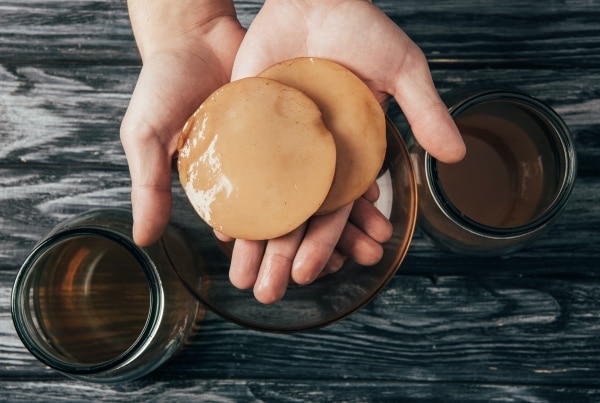Contents
- 1 A Beginner’s Guide To Preparing Kombucha At Home!
- 2 Maintains Gut Health
- 3 Anti-Oxidative Property
- 4 Antimicrobial Property
- 5 Antiglycemic Properties
- 6 Boost Metabolism
- 7 Reduces Inflammation
- 8 Growing A SCOBY Is The First Step To Preparing Kombucha From Scratch
- 9 Materials Needed
- 10 Ingredients Required
- 11 Procedure
- 12 SCOBY Can Also Be Made Using Minimal Ingredients
- 13 Method
- 14 Get Set For Your First Fermentation!
- 15 Ingredients Required
- 16 Method
- 17 Tips
- 18 Last Round Of Fermentation
- 19 Ingredients Required
- 20 Step By Step Procedure
- 21 Final Note
A Beginner’s Guide To Preparing Kombucha At Home!
Kombucha tea is a fermented beverage that has recently become a well-known United States favorite. Anyone can make kombucha by fermenting either black tea or green and oolong tea with sugar and a symbiotic culture of bacteria and yeast (SCOBY) for seven to ten days. The first literature on kombucha comes from the 19th century from Russia and Ukraine. It was circulated to new countries post World War I and was brewed in Germany as a medicinal beverage by 1920.
Its vast health-related benefits support its admiration as a beverage. Its multiple available properties, such as anti-oxidative, anti-inflammatory properties, also regulate essential metabolism in the body. Kombucha also reduces blood pressure and cholesterol levels; its effects on lowering cancer progression and improves liver activity make it a refreshing beverage. Let’s note Down some more positives of kombucha.
Maintains Gut Health

Kombucha is rich in prebiotics, and it is an ideal component of the diet to maintain the gut microflora (friendly microbes living in the gut). It, in turn, improves functions related to the gastrointestinal system. It is widely known as mushroom tea due to bacteria and yeast forming a mushroom-like film on the tea’s surface. A good microflora also boosts immunity.
Anti-Oxidative Property

Being an antioxidant, it keeps the harmful radical species at bay. Mostly when made with green tea, it provides antioxidant effects to the liver. A study on rats demonstrated that drinking kombucha regularly reduced liver toxicity caused by exposure to the toxic chemical by more than 70%.
Antimicrobial Property

Acetic acid is the core substance produced during the fermentation of Kombucha. This acetic acid is capable of killing potential harmful microbes. When made explicitly with green or black tea, kombucha shows strong protection against bacterial and fungal infection and promotes heart health. One of the mice’s investigations showed that low-density lipoprotein (LDL) and high-density lipoprotein (HDL), both of which are good and bad cholesterol, respectively, and markers of cardiac health.
Antiglycemic Properties

Kombucha mainly protects individuals diagnosed with type two diabetes. Studies have reported that kombucha can reduce the digestion of carbs, which further reduces blood glucose levels. If prepared using green tea, it provides additional benefits as green tea also lowers blood glucose levels.
Boost Metabolism

Green tea, when added, specifically adds to the benefits of kombucha to a faster metabolism.
Reduces Inflammation

The significant component of kombucha is tea. Tea containing essential chemicals such as polyphenols acts as an antioxidant that keeps inflammation away.
Growing A SCOBY Is The First Step To Preparing Kombucha From Scratch
Materials Needed
- Kitchen Scale To Weigh Ingredients
- Saucepan To Boil The Liquid
- Hot Plate For Heating
- Heat Resistant Glass Jar
- Cloth Material To Protect The Culture Tank
Ingredients Required
- 0.5 Liter Of Water
- About 7.5 Grams Of Tea Powder
- 50 Grams Of Sugar
- 50 ml Apple Cider Vinegar
- 50 ml Of A Previous Batch Of Kombucha
Procedure
Step 1
Sterilize the glass jar by boiling it for a few minutes.
Step 2
In the jar, prepare tea and add sugar to it. Let it cool down to room temperature.
Step 3
Pour the older batch of kombucha or some store-bought kombucha into the prepared tea jar.
Step 4
Fill the rest of the jar with cold water and cover it with tightly woven cloth.
Step 5
Secure the cloth tightly with a rubber band. Make sure there is no room for any air or dust particles to get into the jar.
Step 6
Keep it for about two weeks, and you will observe your SCOBY on the surface of the tea.
Step 7
It will take about three to four weeks for your SCOBY to grow into a thick batch. Once ready, remove the SCOBY and use it to brew your batch of Kombucha.
SCOBY Can Also Be Made Using Minimal Ingredients
- Two Teabags
- 2 Tbsp. Sugar
- 3 Cups Water
- Store-Bought Kombucha
- Half- Cup Of Starter Tea
Method
The first step is to boil the water and add the tea bags. Once the tea’s flavor and color have gone into the saucepan, add sugar and stir it. Let the tea cool to room temperature. Once cooled, pour the store-bought kombucha and cover your jar with a cloth. Set it into a dark room and leave it for two weeks or so.
Get Set For Your First Fermentation!
Ingredients Required
- 7 Cups Of Water
- Half Cup Of Sugar
- Four Bags Of Tea Powder Plus 2 Tbsp. Of Loose Tea
- 1 Cup Unflavored Starter Tea
- Started Kombucha
- One Prepared Scoby For One Container
- A Jar To Hold Your Kombucha
- A Cloth And Rubber Bands
Method
Step 1
Boil water in a clean saucepan and remove the pan from the heat. Add some sugar and dissolve it.
Step 2
Pour the tea bags into the pan and let them cool to room temperature. It will take a couple of hours. Do not rush into placing the SCOBY.
Step 3
Pour the sweetened tea into the jar, followed by the starter kombucha.
Step 4
Next, place the prepared SCOBY into the jar and cover the jar’s top with a cloth and secure tightly with a rubber band.
Step 5
Place this solution in a dark room for seven to ten days.
Tips
A warmer environment makes for faster fermentation.
You can preserve two cups of this round to use as a kombucha starter for your next batch.
Last Round Of Fermentation
Here, you can play with the flavors and remember that carbonation gives Kombucha its effervescent fizz….
Ingredients Required
- The First Batch Of Homemade Kombucha
- Sweetening Agents Such As Jaggery, Fruit Pulp, Honey, Or Just Sugar
- Raisins, Ginger, Lemon, Or Any Citrus Fruit Juice
- It is advisable to use fermenting bottles as they are well designed for fermentation and are airtight to keep all the oxygen and fruit flies out of the solution.
Step By Step Procedure
Step 1
Firstly, strain your first batch of Kombucha, and using a funnel, pour it into the fermenting bottles. Make sure to not fill it up to the lid and leave some space for the aeration.
Step 2
Add your flavoring agents, raisins, or fruits and correctly seal the bottle.
Step 3
Store the bottles in a dark cupboard for five to ten days.
Step 4
If desired, you can strain out the fruits before serving Kombucha. (can also be stored in the refrigerator after the fermentation procedure is completed to serve it nice and chilled).
Final Note
The significant component of Kombucha includes tea. In many countries, tea is traditionally a medicinal beverage. If you have diabetes, you can go the healthy way by avoiding sugar and using jaggery or natural citrus fruit pulp. It may taste sour initially if it’s not fermented well. A good fermentation will balance the tart and sweet taste, and therefore, you can taste it after the first week of your final batch storage. Ideal storage of 2 weeks is necessary to get the right taste and balance of the different components used.
Kombucha is perfect for all occasions. You can gulp it as soon as you get out of the bed in the morning to awaken your bowels or have a mid-day drink. You can also serve it chilled for parties and dinners.


